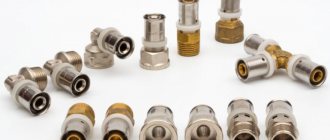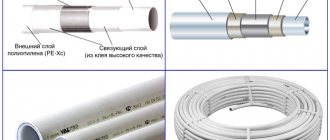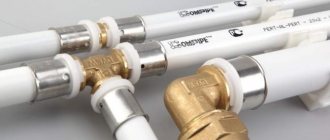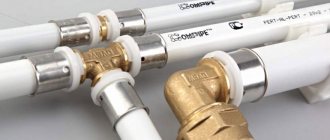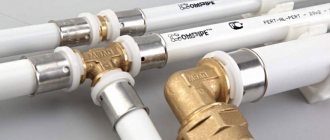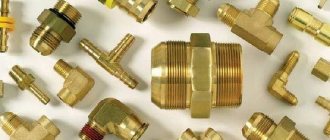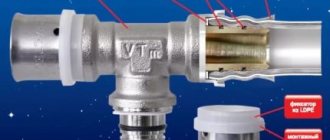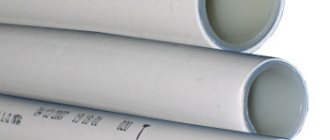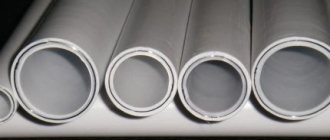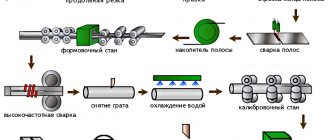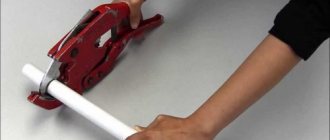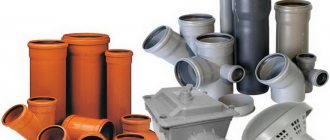Any pipeline system consists of connecting elements - fittings, which serve not only to connect sections, but also act as flow separators when branching the main line, and to redirect the movement of the working medium. Push fittings are a new type of connecting parts that have been developed recently. This is a self-locking part for a strong connection and a secure grip on the pipe.
Push Fit Design
Push fittings are a system consisting of four elements: a body, an O-ring, an internal spring ring, and an outer casing.
The first element of the fitting is the body
— made from polyphenylsulfone. This is a modern, high-strength and technologically advanced material. Today, polyphenylsulfone is a direct competitor of metal in terms of strength characteristics. In addition to strength, this material is resistant to significant temperature changes and shocks.
O-rings
made of rubber that can withstand high temperatures and allows the connection to be completely sealed. EPDM rubber is also wear-resistant, so the service life of the pipeline connected with push fittings is increased.
a spring-loaded ring inside the fitting
, which is also made from polyphenylsulfone. With its help, the pipe can be fixed in the correct position. This ring completely covers the pipe both from the outside and from the inside, but does not damage it.
From the outside, the pipe is fixed using an outer casing
. It is also made from polyvinyl sulfone. A special feature of the casing is that there are several holes on its base that allow you to check whether the pipeline is completely inserted into the fitting.
In a word, the design of the push fitting is such that it allows not only to perform a reliable connection of pipes, but also to do it almost professionally.
Types of breakdowns
Push fittings are resistant to mechanical stress and can withstand high pressure very well - they are quite difficult to break. But it is worth remembering that the fasteners cannot withstand temperatures above 100 degrees, which means it is not very wise to install them on central heating pipes.
When installing, you need to take your time, carefully checking the fasteners and waiting for the characteristic click when the pipe fits completely into the grooves.
Make sure that the diameter of the pipes matches, otherwise the fastening will leak. If faulty, the fitting must be replaced.
Push fittings have many advantages. The main disadvantage of such pipe fixation can be considered the high cost.
Push-Fit
Advantages of Push Fit pipe installation systems for heating and water supply:
- This connection fixing system allows installation without special soldering, welding, crimping, sliding or pressing tools. There is no need for energy sources for them;
- In addition to saving on the cost of expensive installation tools, high qualifications and professionalism of installers are not required. Skill and dexterity are acquired literally in the first minutes of work;
- To carry out installation, you only need to have pipe cutting scissors and a calibrator;
- The speed of installation work on laying pipes for cold and hot water supply and heating increases significantly.
Quick installation fittings (push fittings) are made from materials such as:
- PPSU (polyvinyl sulfone or polyphenylene sulfone). This plastic/material has high impact strength, deformation resistance, heat resistance, and chemical resistance. Coefficient of thermal expansion – 5.5 mm/mm/°C PROVIDE INFO !!!!! ;
- PVDF (polyvinylidene fluoride). This fluoroplastic (fluorine-containing polymer) is a polymer of vinylidene fluoride. It has good mechanical strength and wear resistance, hardness, chemical resistance and resistance to ultraviolet radiation, low flammability;
- Brass. Traditional material for plumbing fittings;
- PB (polybutylene or polybutene). This material, a thermoplastic polymer of butylene (butene), is a member of the polyolefin family. It has excellent long-term resistance to high temperatures (temperature resistance), high resistance to cracking, good chemical resistance. Polybutene is a valuable material for the production of pressure pipes for heating, hot and cold water supply.
Push-fit pipeline systems (push fittings) and corresponding pipes on the Russian market are offered by such brands as TECE (Germany), Henco (Belgium), Elsen (Spain), Metzerplas (Israel), Giacomini (Italy), BLANSOL ( Spain), COMISA (Italy) and some others.
Comparison of the main parameters of connection systems with push fittings:
| System name | Diameter | Fitting material | Threaded connection material |
| TECElogo | 16, 20, 25,32, 40, 50, 63 | PPSU (polyvinyl sulfone) | brass, bronze, stainless steel |
| HENCO Vision | 16, 20, 26 | PVDF (polyvinylidene fluoride) | brass |
| ELSEN Push | 16, 20, 25, 26, 32 | PPSU (polyvinyl sulfone) | brass |
| Metzerplas SP-EF | 16, 20, 25, 32 | Brass | brass |
Push-fit systems also have other names in common use, for example, push-in-fitting or quick fit, as well as push fit connectors or quick pipe connections.
Push Fitting – modern technology of quick pipe connections.
What materials are they made from?
The raw material for manufacturing is polyvinylidene fluoride (PVDF). It is one of the polymers obtained by polymerization from vinyl denfluoride. It has a second name - fluoroplastic-2. The material is durable, can withstand operating pressures of up to 10 bar, and can withstand temperature changes from -40 to +150 °C. Can be used in drinking water supply pipelines.
Polyphenyl sulfone (PPSU), which is used by some manufacturers to make housings, has approximately the same properties.
On sale you will also find push connectors made of brass, the property of which is to withstand temperature fluctuations is well known.
Design of connecting elements
Despite all the diversity in appearance and configuration, push fittings have a common design with other products:
- the presence of an outer casing (with its help, fixation (fastening) occurs);
- all connecting elements are located in a housing that withstands external physical influences well;
- have sealing rings and are made of especially durable rubber (it is not susceptible to high and low temperatures);
- are equipped with a spring-loaded inner ring, with the help of which the pipe is securely, absolutely sealed (the ring, going inside the pipe, covers it from the outside).
Positive aspects of use
Push fittings should be used specifically for metal-plastic pipes when laying plumbing and heating systems for the following reasons:
- Very easy installation. Any person who does not have special experience can cope with the task of installing the pipeline with his own hands without any special tools.
- Time spent on work. Basically, it goes into cutting the pipe to a certain length, and the connection of individual pipeline elements occurs in a matter of seconds.
- Reliable connection. The entire system assembled using this technology will be absolutely sealed and, over time, the occurrence of leaks is completely excluded.
- Convenient installation. Since push fittings using this method do not require special tools or devices, installation can be carried out even in places with limited access and in close proximity to the wall.
- Long-term operation without the need for repairs. The phrase “set it and forget it” is completely suitable for a push fitting.
- During sudden temperature changes (freezing followed by thawing), the quality of the connection does not change.
- The ability to withstand high temperatures - 95ºC (for products made from PPSU) and 150ºC for products made from PVDF.
- When changes are made to the piping system, old connectors are easily removed and can be reused.
- The absence of harmful components in the structure of the material allows it to be used in pipelines with drinking water.
Functional varieties
There are different types of connectors that are designed for specific use when laying a pipeline:
- angle (elbow, bend), required to change the direction of the pipe by 45-120ºC. Installed when turning the pipeline in the corners of the room or when bypassing existing obstacles;
- fitting - a device that allows you to directly connect an automatic dishwasher or washing machine to the pipeline through a flexible (soft) hose;
- tee - added to the main line to divert towards a separate pipeline branch;
- crosspiece - allows you to make wiring on two sides at once;
Types of push fittings (straight and outlet)
- coupling (straight) - the simplest connector that fastens two pipes with the same diameter and running along the same line;
- adapter – necessary when connecting pipes of different diameters;
- plug - used to seal the free end of the pipe.
Phased pipeline installation
To install water supply systems made of metal-plastic pipes using push fittings, you should follow the following sequence of actions:
Push fitting installation
- Cut the pipes according to the size of the traversed areas. It is better to do the work with special scissors, but if you don’t have any, a regular hacksaw for metal will do.
- Carry out calibration (chamfer the ends and make sure there is a completely round hole).
- Place the required connecting element on the first pipe. The correctness of its position is determined by the control holes in the fitting body.
- Insert the second piece into the free end of the fitting and fix it securely.
Push fittings push fit yes or no
≡ January 30, 2017 · Category: Interesting to know
We all often have to install various water systems in the construction work of a summer house, a house outside the city, or even during capital construction. renovations in living space. How can this process be simplified?
The answer is simple: Use push fit connectors, which are distinguished by their strength, tightness of the connection and speed of installation. Plus, they don’t ask for expensive tools: all you need are special scissors (for pipes) and a calibrator.
Features of installation work
Explanations for installation It should be noted that the developed push connectors are suitable for both metal-plastic pipes and ordinary plastic ones, which greatly expands the possibilities of their use.
Apart from the fact that these parts can withstand fairly high pressure and temperatures of up to 95 degrees Celsius. So, they can be successfully used not only for supplying drinking water, but also for heating systems.
Advice
Thanks to these new generation connectors, the installation process itself is changing. Now there is no need to use many additional tools, including a press to secure components: everything can be done with your own hands. This saves a lot of time and effort, so it will take very little time to lay out the system.
It’s very interesting: according to the calculations of professionals, if you compare the installation process where push fit connectors are used and conventional crimp connectors, then in the first option up to 80% of time is saved. So within a day you can install a heating system and a water metering unit, and begin finishing work.
A few cons
But, despite its own advantages, it is necessary to take into account several disadvantages. The first is that the material of the connectors and their design itself are not designed for extremely high temperatures.
The first is that the material of the connectors and their design itself are not designed for extremely high temperatures.
But we all remember very well that centralized heating in the city does not stand out for its stability and quality, which is why temperatures there exceed 100 degrees (not to mention water hammer and increasing pressure).
So in residential areas they are not recommended for heating systems, but in privatized houses, where you personally control everything and everyone - it’s easy.
The second disadvantage is the cost. Such connectors are much more expensive than standard ones. See for yourself:
- A pipe-to-pipe type coupling will cost about 260 – 460 rubles, depending on the diameter.
- A corner with a coupling will cost much more - 270 - 585 rubles.
- 90 degree tee - from 390 to 670 rubles.
- The installation kits that are needed to create water outlets (water taps will be mounted on them) cost approximately 1,300 rubles.
- Plugs – 190 – 430 rubles.
Note: prices are correct at the time of publication (spring 2015).
Of course, these are average prices, as they can vary both up and down. It depends, as it always does, on where you choose to purchase your push fit connectors and on the brand.
pros
It is necessary to emphasize here that the system assembled using such connectors is compact, so it is ideal for buildings with thin partitions (especially if you need to carry out work on them). It is also perfect for today's underfloor heating.
Another thing is also very important: the material from which the parts are made is modern and is often used in NASA and medicine. So it's actually durable and environmentally friendly
The latter, by the way, must be taken into account, since the general environmental situation on earth is no longer encouraging - you need to worry about your health in different ways.
Well, let's remember about convenience: to use such connectors, there is no need to call professionals or buy expensive tools. After all, everything can be done with your own hands. So in this option, the cost of push fit connectors will not be a serious obstacle.
How to install using push fittings
Let us note once again that installing utility lines using these connecting elements is quite simple. Before starting work, prepare the necessary tools
. You will need scissors that can be used to cut pipes made of plastic or metal-plastic. If special scissors are not available, you can use a hacksaw.
In the latter case, you may encounter that the cut made with a hacksaw has uneven edges. To fix this problem, the hacksaw needs to be processed using coarse sandpaper.
You will also need a calibrator. With its help, the pipes are returned to their original shape. This is necessary, since during the cutting process the pipe may slightly change its cross-section and become oval rather than round.
When all the tools are ready, you can start working. First you need to cut the pipe to the required length. Then calibrate it by doing the work manually or using electrical equipment. In the latter case, you should choose a speed not exceeding five hundred revolutions per minute.
Let us immediately note that the round shape is of particular importance when using push fittings. If the pipe is oval or takes on another shape, the O-ring may be damaged when the connecting element is installed.
After calibration, you need to put the fitting on the pipe all the way and make sure to what depth the fitting is put on. Special holes are used for this.
Today, metal-plastic pipes have almost completely replaced metal products. This is quite easy to explain, since metal-plastic pipes are convenient to install and can be used for a long time. And if you use push fittings during the installation process, the work will be done better and the connections will be more reliable.
Installation and replacement rules
Manufacturers emphasize that push fittings should only be used on recommended pipes. Each has its own nuances in the technology of connector production, so when using materials from different companies, discrepancies in sizes are possible.
Important importance is attached to the processing of the end of the connected bends. They must be cut at right angles, have an even chamfer and be clear of chips.
If you replace the docking unit after dismantling, you must use a special replacement kit from the manufacturer.
Installation technology
Installation of the Push Fit quick docking involves 3 steps:
- The pipe is cut at a right angle. To do this, use a pipe cutter (but not a hacksaw or grinder).
- The end is processed with a calibrator until a smooth chamfer is obtained. Remove the chips.
- Insert the tap into the push connector with slight force until you hear a specific click. On some fittings, you can check the pipe's entry into the connector through windows in the holding block.
A failed connection can be removed and replaced. To do this, unscrew the block and cut the plastic guide ring with a tool. Next, screw in the replacement kit and repeat the joining process.
Push fitting for metal-plastic pipes
Push fitting is a new pipe connection technology intended for use in the installation of heating and water supply systems. The push fitting technology is based on the idea of simplifying the installation process and an attempt to get rid of the use of additional special equipment.
The developers tried to make installation extremely simple: to connect, just align the parts and press them until they click. Hence the name of the development, Push Fit, which means “force” and “reinforcement”.
Do-it-yourself installation of push fittings
Despite the fact that the idea of push fitting is based on the desire to get away from the usual installation equipment, in the Push Fit kit you will have to additionally purchase pipe scissors and a calibrator.
A strong connection can only be achieved if the preparatory work is carried out correctly.
First, using special scissors, the edge of the pipe being installed is trimmed. This is done to eliminate possible irregularities on the cut surface. Then the pipe is calibrated and chamfered at an angle of 45 degrees. After which the prepared pipe is inserted into the push fitting. The connection is ready when a click is heard.
Important
It is easy to check the strength of the connection. It is enough to pull both parts in different directions.
At first glance, the connection is quite strong, but how reliable it is can only be learned from practical operating experience.
It should be noted that the pipe, clamped in the fitting with a relatively small force, rotates, which suggests that the connection is unreliable.
Experienced plumbers who are responsible for the quality of their work will never use such a rotating connection for hidden installation or for laying it in a concrete screed.
Where and how are push fittings used?
Despite some mistrust of professional craftsmen towards pushfitting, this technology will certainly find application when carrying out plumbing work with your own hands. Of course, we are not talking about large-scale work and installation of heating or water supply systems, but about minor repairs, replacing a faucet or a broken heating device.
It is better to use a push fitting in private heating systems with a low level of pressure. In apartment buildings, it is better to use more familiar, time-tested methods of connecting pipes.
But even with minor repairs, pushfit connections must remain under constant control.
Taking this into account, a push fitting can be considered a kind of “ambulance” for heating and water supply systems, with the help of which you can easily and simply troubleshoot the system without having either special equipment or installation experience.
How does Push Fitting work?
The push fitting consists of a fairly durable body, for the manufacture of which various materials can be used, ranging from the usual brass to modern polymer materials with unique properties (heat resistance, mechanical strength, etc.).
It is clear that the material used for the manufacture of fittings largely determines the cost of the finished product. It should be noted that push fittings cannot be called cheap equipment; rather, on the contrary, their cost may determine the feasibility of further use of this installation technology.
So, for example, a push angle costs, depending on the diameter, from 360 to 690 rubles, a coupling from 370 to 870 rubles, and a tee from 600 to 900 rubles. For comparison, a regular coupling made of good quality polypropylene costs from 6 to 100 rubles.
Advice
There is an O-ring on the body fitting that protects against possible leaks. The main part of pushfitting is a coupling and a spring-loaded ring that grips the pipe and holds it.
The reliability of the connection depends on the quality of the grip and on the reliability of that same spring-loaded ring. Manufacturers of new fittings assure that they can be reused, but practical experience suggests that with repeated use the spring will probably weaken and it is better not to count on a high-quality and strong grip.
Let's sum it up
Alas, today a push fitting can only be considered as an ambulance when it is necessary to carry out quick repairs without the participation of specialists in the field of plumbing.
Properties of push fittings
Fittings of this type are a compact system consisting of plastic connections. They are designed to easily install metal-plastic pipes.
During the installation process using push fittings, no special tools are required, as well as knowledge and skills that only professionals possess.
Push Fit allows you to cope with the most difficult cases that arise during installation work. This becomes possible due to the fact that these fittings
- easy to install;
- have a smooth profile;
- have little weight.
Thanks to them, awkward corners and narrowed spaces where pipelines are located in modern apartments are no longer a hindrance during installation.
Advantages and disadvantages
Push fittings stand out among the vast sea of connectors with the following advantages:
- High speed connections.
- Ease of installation of pipelines as a result of their use.
- An original design, which becomes more airtight as the pressure in the system increases.
- According to the manufacturers, it is possible to reuse the structure after dismantling.
- No need to purchase expensive tools.
The main disadvantage of push fittings is their high prices.
There is an opinion that they are not suitable for closed installations, since the consumer will not have the opportunity to control the state of the connections.
